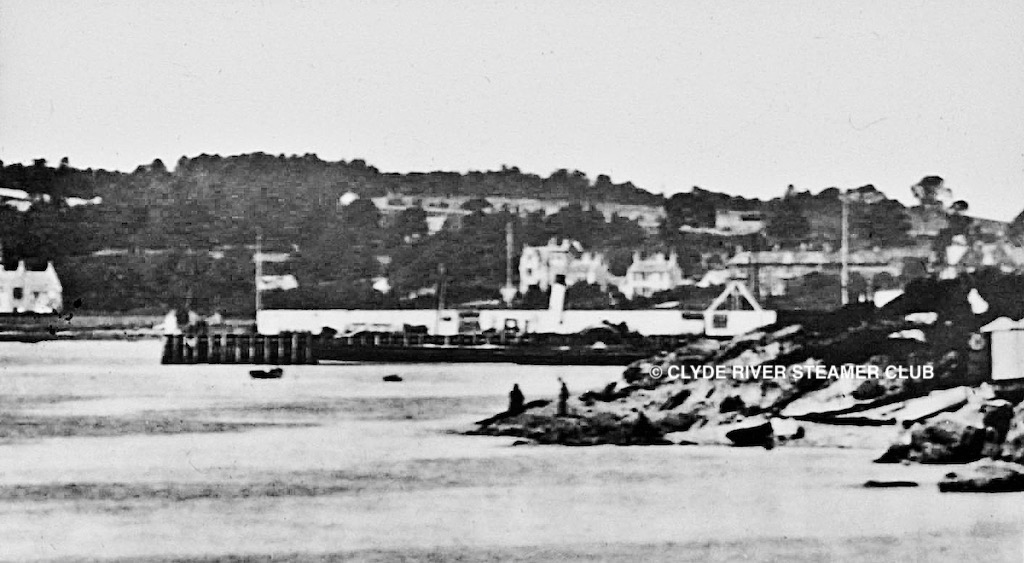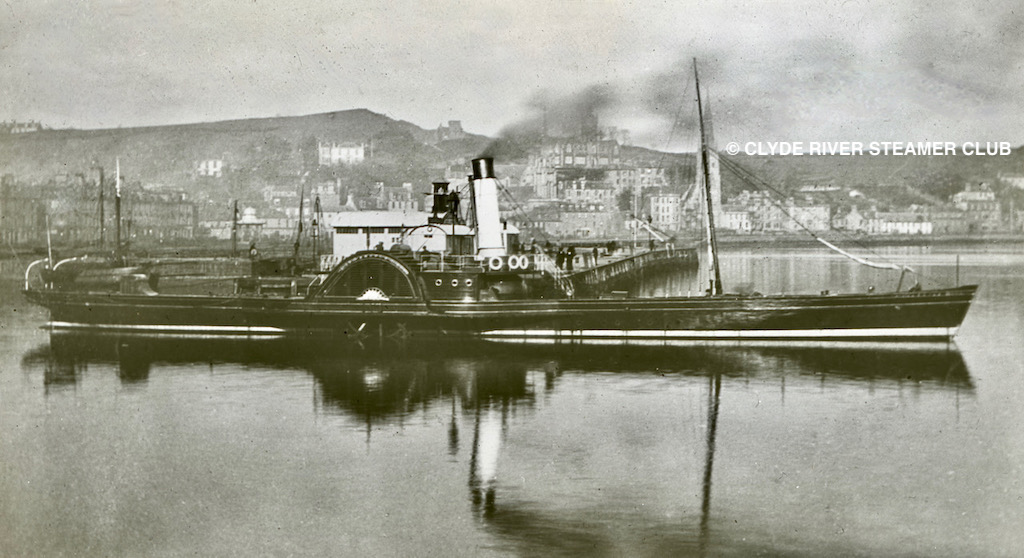
‘An excellent sea boat, very lively, but very dry, not fast, but an invaluable boat for the winter service’: Andrew McQueen’s description of the Wemyss Bay Steamboat Company’s Argyle, built by Barclay, Curle at Stobcross in 1866, sold to Gillies & Campbell in 1869 and pictured at Rothesay c1880
Graeme Hogg’s comparison of the pioneering Clyde steamer books by Captain James Williamson and Andrew McQueen has already uncovered numerous differences of style and perspective. Williamson’s Clyde Passenger Steamers from 1812 to 1901 and Andrew McQueen’s Clyde River-Steamers of the Last Fifty Years were published in 1904 and 1923 respectively, and are still available on the secondhand market. The son of a great Victorian steamer entrepreneur, Williamson (1852-1919) won his spurs as an engineer and captain, and later achieved distinction as manager of the Caledonian Steam Packet Company. McQueen (1868-1933) was an acknowledged authority on the steamers of his day. At the inaugural meeting of CRSC in 1932 he became the obvious choice for Honorary President.
Graeme points out that their books overlap for a period of 30 years, from 1872 to 1901: “Both authors describe and comment on all the ships of that period (105) to a greater or lesser extent, as well as other aspects of ship layout, machinery, personalities. Williamson writes from an insider’s perspective, and tries to be dispassionate about everything, although his prejudices do emerge. McQueen, by contrast, is writing as an enthusiast — quite direct in his opinions and a lively writer.”
Having begun this series by comparing the two authors’ descriptions of the earliest steamers known to them and the late 1870s Rothesay flyers, Graeme now looks at their writings on the first Wemyss Bay steamers.
The current Wemyss Bay-Rothesay ferries, Bute and Argyle, are pretty well suited to their duties and provide Brandanes with a good service. When they were introduced, it was noted that their names revived those of older vessels to have served the island. In Bute’s case, reference tended to be made to the third of the pioneering ABC car ferries of 1954 or to one of the cargo steamers of earlier years, whereas in the case of Argyle, she was reviving the name of a ship from the 19th century. In fact, there was a 19th century Bute also associated with the Wemyss Bay-Rothesay service. We can learn more about these earlier vessels from the writings of Captain James Williamson and Andrew McQueen, who, in the case of Argyle at least, were eye-witnesses to the ships and their operations.
Work started on the Greenock & Wemyss Bay Railway in 1862. The intention of the new railway was to speed up services to Bute, Largs, Cumbrae and beyond, by shortening the seaward legs of the journey when compared to the existing Glasgow or Greenock routes. The line was developed as a single track running from just west of Port Glasgow station and effectively behind Greenock. The company also formed the Wemyss Bay Steamboat Company, with the intention of operating its own steamer connections from Wemyss Bay Pier. Two saloon steamers were ordered from Caird & Co of Greenock and a smaller flush decked steamer, Largs, from Thomas Wingate for the Largs and Millport connections. The second of the Caird vessels was Bute, which appeared in 1865. Williamson describes her and her sister ship Kyles as “well appointed steamers, with deck saloons fore and aft”, adding that they “were most attractive boats for the development of the new route to Rothesay”.
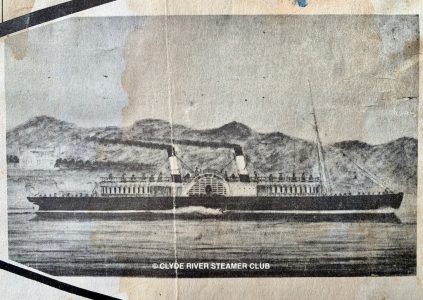
This drawing of the Wemyss Bay Steamboat Company’s ‘most attractive and well appointed’ Bute of 1865 was used on the front cover of the inaugural edition of ‘Clyde Steamers’ in 1965
Williamson continues: “Evidently it was the intention of the Wemyss Bay Railway directors to ‘scoop the pool’ with their new fleet”.
The reality proved to be somewhat different. Whether due to inexperience or bad management, the operations were a disaster. Timetabling was much too tight and the ships were unable to keep to their schedules, leading to trains running late which, with the single track working of the line, caused chaos. As a result, the anticipated traffic failed to materialise, passengers preferring to stick with the Glasgow or Greenock connections.
The company quickly decided to cut its losses and both Kyles and Bute were sold in 1866 to London owners. Bute’s Clyde career was so short that it is not even mentioned by McQueen, whose account begins in 1872. In a tragic postscript, Bute, renamed Princess Alice for the Thames, met a tragic end when run down by a collier while on an evening cruise in 1878. She split in two and sank with the loss of over 650 passengers, the biggest loss of life in the history of British coastal shipping.
Curiously, Williamson describes the disaster but mistakenly states it was Kyles which sank. She had been renamed Albert Edward when sold to the same owners, so there should have been no confusion. She was broken up in 1888.
In an attempt to salvage the situation, the Wemyss Bay Steamboat Co devised a less ambitious schedule for 1866 utilising Largs as before, Victory, which had been acquired from Duncan Stewart in 1865 to alleviate the problems being experienced, and a new ship, Argyle on the Rothesay run. She was a modest flush decked steamer of 177 feet, built by Barclay, Curle & Co, also to the order of Duncan Stewart. Presumably her initial cost was moderate as she was fitted with the engine of his Alma of 1855.
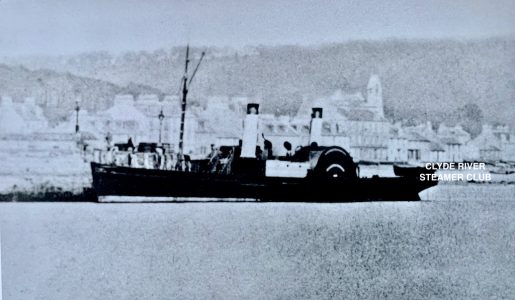
The twin-funnelled, flush-decked Largs at Millport. The least attractive of the Wemyss Bay steamers, she was built for the fledgling Steamboat Company by Thomas Wingate at Whiteinch in 1864-65 and used mainly for the Largs and Millport trade. Bought (along with Argyle) by Gillies & Campbell in 1869 after the ill-starred Steamboat Company went into liquidation, Largs was sold in 1877 to Waterford in Ireland, where she was renamed Mermaid and broken up in 1903. Click on image to enlarge
Nevertheless, according to McQueen, “with a beautifully modelled hull, she was an excellent sea boat, very lively, but very dry, not fast, but an invaluable boat for the winter service”.
Even this more workable timetable failed to find favour with the travelling public and, in 1869, the Wemyss Bay Steamboat Co went into liquidation.
Williamson describes what happened next: “An arrangement was then made between the Wemyss Bay Railway Company and the private steamboat owners. Messrs Williamson, McLean and Buchanan undertook to attend to the Rothesay trade and Messrs Gillies & Campbell and Graham, Brymner & Co arranged that their steamers should call at Wemyss Bay on the route between Glasgow, Greenock and Millport. Instead, however, of all these steamboat owners (Gillies & Campbell excepted) doing their best to develop the traffic as they ought to have done, some of them were foolish enough to think they could bring about the collapse of the Railway Company and wipe out the objectionable Wemyss Bay route altogether.”
According to Williamson, these private operators did not get very far with their gambit: the railway company was not going to give ground so easily. “In their determination to secure a reliable service, the Railway Company made a new exclusive arrangement with Gillies & Campbell, and placed the Largs and Argyle under their management to run along with the old Largs boat, the Venus”. Fares were reduced at the same time and the arrangement prospered over the next 20 years. Argyle remained in the fleet until sold to Dundee owners in 1890, before finishing her career in Spain.
Thus, in spite of its inherent advantages, the Wemyss Bay route had difficult beginnings. Argyle was successful in her modest way, but must have been quite dated, offering poor facilities to regular travellers of the day. She and subsequent additions to the Wemyss Bay fleet were outclassed by the opulent new steamers introduced to the route when the railway-financed Caledonian Steam Packet Company appeared in 1889-90, and scarcely bear comparison with the large, comfortable, if not hugely attractive, ships on the service today.
All images on the CRSC website are protected by copyright law. Do not reproduce them on Facebook, Pinterest or any other public platform.
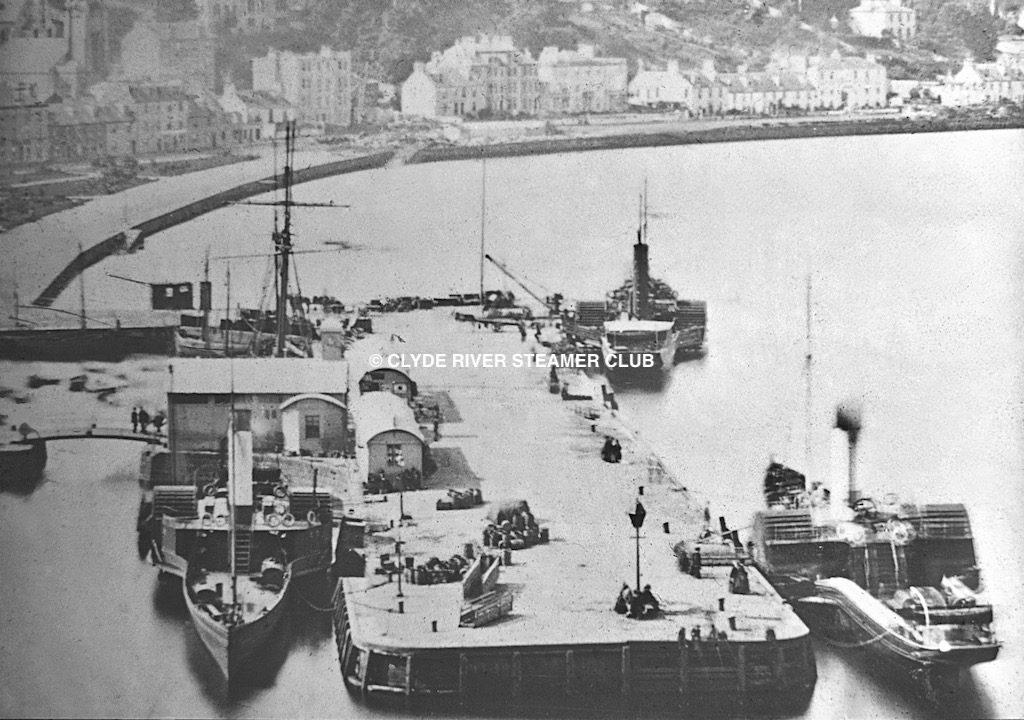
The Wemyss Bay steamers Lady Gertrude of 1872 (inner harbour) and Argyle of 1866 at Rothesay — a photo dating from before January 1877, when Lady Gertrude was wrecked at Toward. The vessel at the far end of the pier, with aft canopy, is an unidentified ‘doon the watter’ steamer
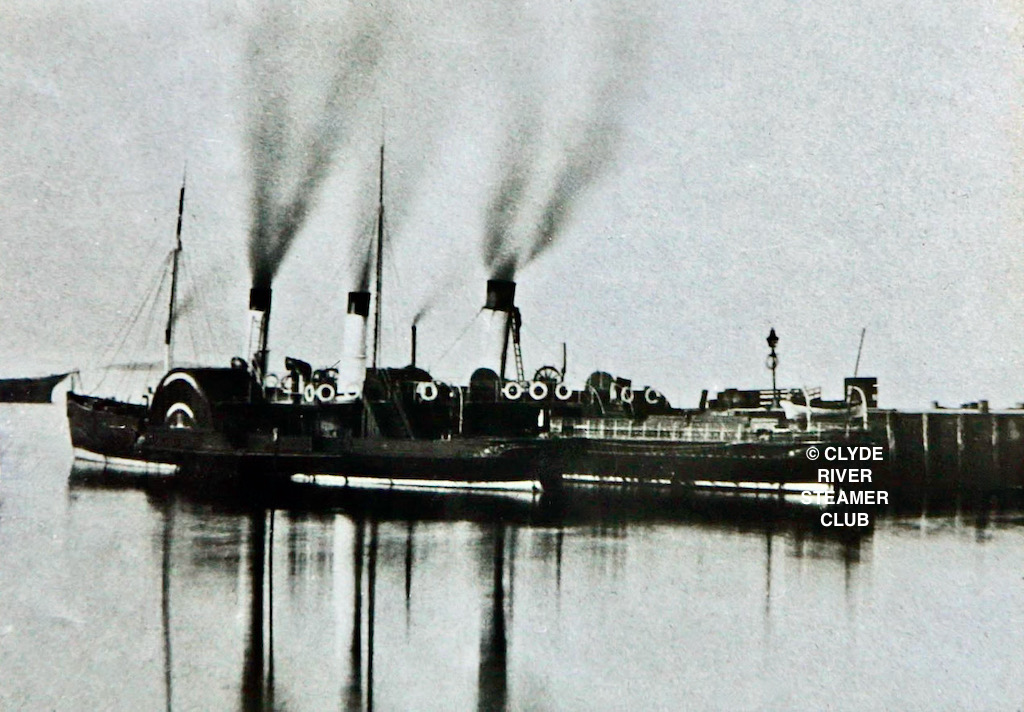
Largs (foreground) at Millport c1874. She is berthed outside the raised quarter deck steamer Lancelot, built in 1868 for the ‘doon the watter’ trade and taken over by Gillies & Campbell in 1875 for their Wemyss Bay services. She was later sold to Constantinople
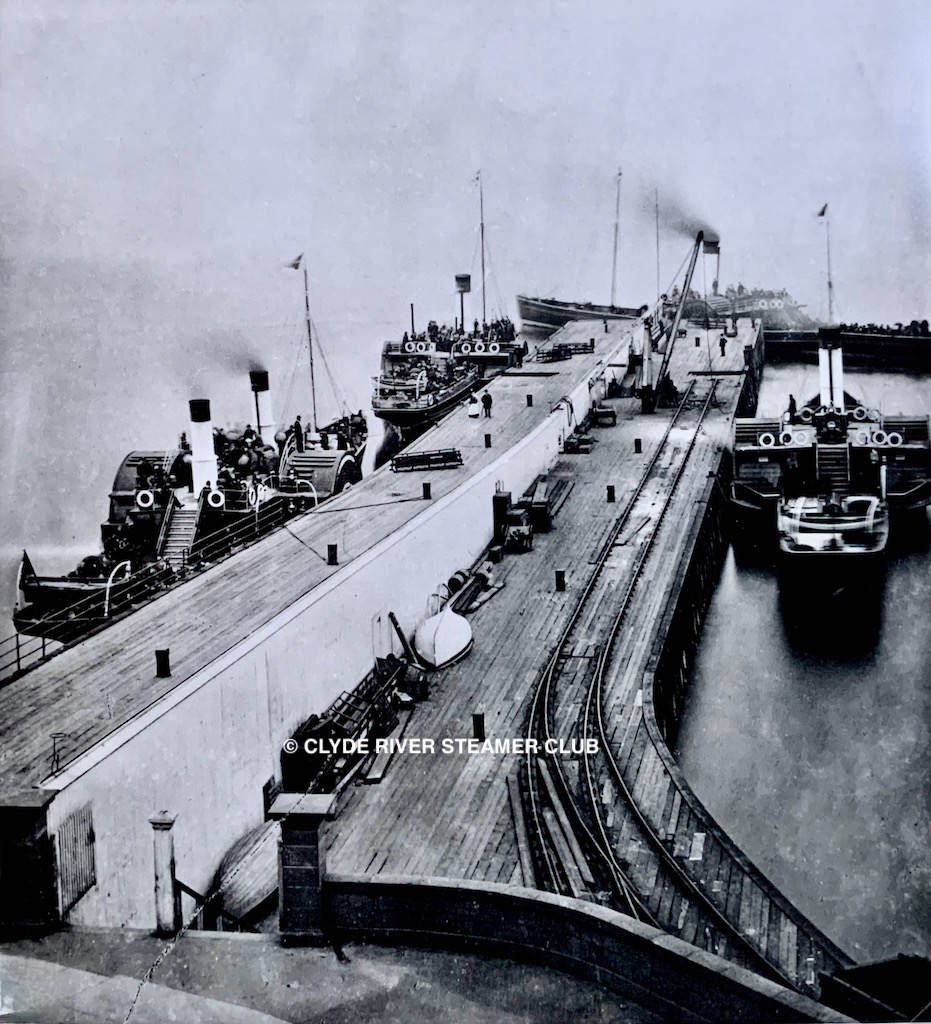
The Wemyss Bay fleet c1875, with Largs on the left, Lancelot ahead of her, Lady Gertrude on the pier-end and Argyle on the right
SEE ALSO:
Published on 19 April 2021













